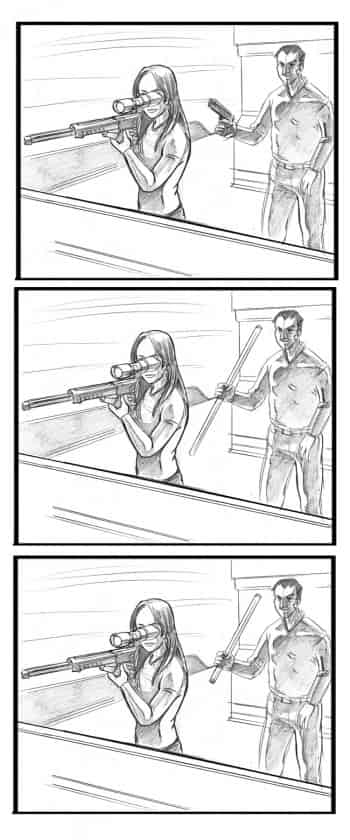
Rédaction
Eviter la surenchère d’actions
Nous lisions, sur des blogues, que des fanatiques de certains comic books (G.I. Joe ou des séries de Marvel) commençaient à perdre la foi. En cours de rédaction, nous nous sommes aperçus que nous ne pouvions pas uniquement nous limiter à des scénarios où nos héros affrontent des robots ou des monstres de plus en plus gros ou encore sont confrontés à une armée adverse de plus en plus considérable que la précédente. Nous voulions éviter le syndrome de la série télé 24 où la menace à désamorcer est plus imposante que celle des séries antérieures. Une telle approche ne peut conduire qu’à un cul-de-sac. Le lecteur sait que les héros vont s’en sortir et qu’il y a une limite à la surenchère de défis toujours plus gros.
Développer le personnage d’Eva
Nous étions conscients que l’univers que nous proposions était formé presque exclusivement de personnage masculin. Nous ne souhaitions pas y introduire un personnage féminin juste pour le plaisir de le faire. Un personnage féminin fade n’aurait pas rendu notre univers plus intéressant. Le lecteur n’est pas dupe, il sent rapidement lorsqu’un personnage a pour seule intention de combler des quotas démographiques ou ethniques. Nous avons donc cherché à lui donner des caractéristiques qui en feraient un personnage fort qui contribuera à l’histoire et non créé uniquement pour meubler les cases d’une page.
La voix intérieure des personnages
Lorsque nous avons lancé le projet, un enjeu nous est vite apparu : les dialogues. Comment faire pour que les échanges entre les personnages n’aient pas tous l’air analogues? Nous avons acheté des livres traitant de la rédaction. Ce défi était abordé, mais de façon décevante. On conseillait effectivement aux auteurs de développer la voix intérieure du personnage. MER-CI du conseil, nous n’aurions pas pu y penser nous-mêmes. Notre expérience nous a amenés à délaisser cette question. Nous avons convenu que des personnages forts, avec des identités bien définies, auraient des actions (gestes et paroles) plus cohérentes. Mais alors, comment développer ces personnages forts? Notre solution a été de discuter avec des amis pour trouver des réponses à des questions de base : pourquoi le personnage agit-il de la sorte? La réponse se trouve-t-elle dans des événements récents ou de beaucoup antérieurs? Comment ces premiers événements ont-ils pu influencer les suivants? Rapidement, un portrait va se tracer et le personnage va prendre forme.
La cohérence des personnages
Créer un personnage qui va évoluer dans différents environnements pose un défi à l’auteur. Ses réactions doivent respecter sa nature propre, ce qui a l’inconvénient de le rendre potentiellement prévisible, donc peu intéressant pour le lecteur. Du même souffle, la dimension temps est une composante importante de nos histoires, ce qui implique que les personnages devraient tirer certaines leçons de leurs expériences antérieures et donc s’adapter et évoluer en conséquence. Naturellement, ces affirmations sont plus simples à écrire qu’à réaliser devant son écran d’ordinateur.
L’archivage et les lignes du temps – Partie I
Comme toutes nos aventures ne sont pas publiées chronologiquement, nous avons pensé à mettre en place le système de ligne du temps afin de positionner nos différents récits.
Toujours Steve Englehart
En octobre 2010, Jeffery Kleahn (jeffreyklaehn.blogspot.com) réalisait une entrevue avec Steve Englehart. Ce dernier déclarait : « If you’re trying to write thrillers like I do, you need a coherent plot, at least as a frameworks. But then you have to let the caracters be who they are. » Ce respect des personnages nous semble essentiel, sinon ces derniers ne seraient que les porte-parole de l’auteur, et ce, au détriment d’une cohérence psychologique.
Revenir sur Steve Englehart
En octobre 2010, Jeffery Kleahn (jeffreyklaehn.blogspot.com) réalisait une entrevue avec Steve Englehart. Ce dernier déclarait : « I was writing Captain America and America was transfiexed by Watergate, and I couldn’t see how Captain America could NOT react to that – so I started commenting on real-world events. I found that even though I was writing fantasy, the more firmly it grounded in reality, the better was. » À notre avis, cette connexion sur une certaine réalité permet au lecteur d’avoir un point commun avec le personnage de fiction.
Commenter une scène : Le baptême de feu
Dans cette aventure, le meurtre de Shumen Datta avait trois fonctions. D’abord, de démontrer le caractère nuancé de la mission du Black Orchestra, ils ne se définissent pas comme les bons sans concession, ensuite, que Benson est un bon soldat qui obéit aux autres sans beaucoup de discussion et enfin que Fabien est bien naïf quant à son rôle.
Commenter une scène : Bataille en mer
Nous avons demandé des ajustements sur une case. D’abord, nous ne souhaitions pas que l’adversaire derrière Kirsten tienne un pistolet (pourquoi être à quelques mètres pour tirer alors que l’on pouvait le faire bien avant?), ensuite, dans une version initiale, l’arme utilisée nous semblait trop longue et le « méchant » n’avait donc pas lieu d’être aussi près de l’héroïne.
Les dialogues intérieurs
Le 22 août 2011, sur le blogue Comicvine, Corey Schroeder expliquait « when we hear inside the head of someone like Superman or even Lex Luthor, it humanizes them, makes them more relatable, and ultimately more understandable. » Personnellement, nous croyons que la dernière portion de l’affirmation est une erreur. Cette volonté d’expliquer le comportement du personnage tend à les diminuer au lieu de les complexifier. Laissons au lecteur le soin de développer son interprétation à partir de ses propres références au lieu d’imposer les vues de l’auteur. La bande dessinée n’est pas un roman, le dessin devrait déjà offrir de nombreuses pistes d’interprétation.





